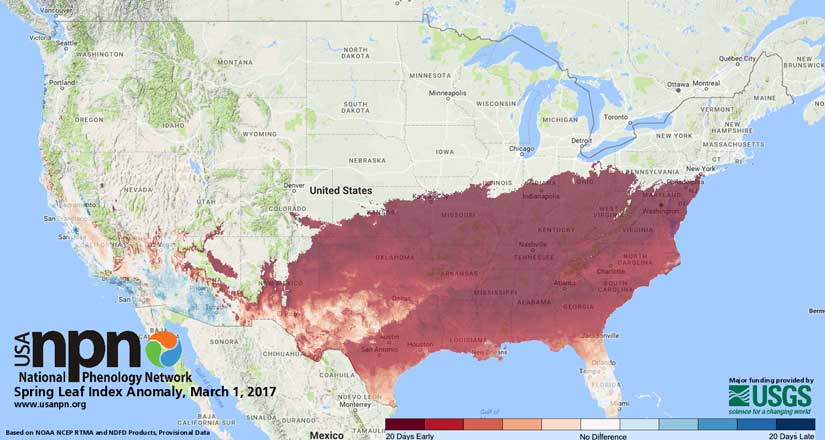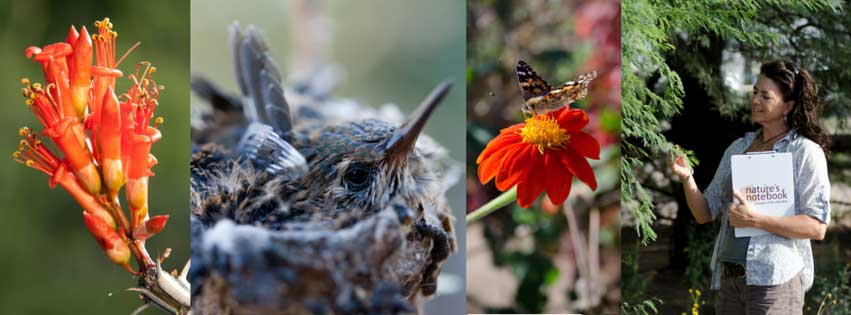The USA-NPN (USA National Phenology Network) has been tracking and mapping the start of the spring season across the country using models called the Spring Leaf and Bloom Indices.
Wait .. push pause and hold on there a second … who?
OK, let’s step back a bit.
The USA National Phenology Network (USA-NPN) monitors the influence of climate on the phenology of plants, animals, and landscapes. It is basically a consortium of individuals and organizations that collect, share, and use phenology data, models, and related information to track what is going on.
And then then quite naturally leads to a question about the definition of the word “Phenology”, so what is that?
That is a word that was coined by the Belgian botanist Charles Morren in 1849 to describe the tracking of plant and animal life-cycle events. Basically this is all about tracking the dates of the first occurrence of biological events in their annual cycle. For example …
- the date of emergence of seasonal leaves and flowers
- the first flight of butterflies and the first appearance of migratory birds
- the date of leaf colouring and fall in deciduous trees
- the dates of egg-laying of birds and amphibia
- the timing of the developmental cycles of temperate-zone honey bee colonies
- etc..
If you happen to live in the UK, then you will be familiar with all this due to annual and popular BBC productions such as SpringWatch, AutumnWatch and WinterWatch.
Having a wide network of people who track all this yields a rich data set and is clearly one that is of great value to researchers because it is something that no individual researcher would be able to gather.
Now knowing all that, you might then wonder who funds the USA-NPN. Basically those with a specific interest in the consistent gathering of such data, namely the U.S. Geological Survey, the U.S. Fish & Wildlife Service, the National Park Service, the University of Arizona, and also the National Science Foundation.
The Headline Item – Spring is very early this year
So this is what has been measured so far …
In 2017, we see very large anomalies in the southeastern United States on the Spring Leaf Index map, where the Index was met up to three weeks earlier than what is typical for these locations.
This does of course open up another interesting question. How exactly do they define the beginning of spring, is it the appearance of the first tiny leaves on the trees, or the first crocus plants peeping through the snow?
They have a very precisely defined spring leaf index and so using that and a series of maps, they can measure the arrival of spring as it rolls forward day by day from the south up into the northern states …

The following map shows the locations that have reached the requirements for the Spring Leaf Index model

Implications
An early spring is perhaps something that should be anticipated because 2016 was the warmest year ever recorded on a global scale.
Having a bit of warmth in February is indeed nice and seeing the landscape green up a bit earlier might also be a welcome change, but all this has implications. The USA-NPN specifically point out some of these …
changes in the timing of spring can affect human health, bringing early-season disease-carriers such as ticks and mosquitos, and an earlier, longer and more vigorous pollen season. And while a longer growing season can result in increased yields for some crops, it is risky because of the higher likelihood of plant damage caused by late frosts or summer drought.
This is really not good news, especially if you have an allergy problem, because it means a longer hay fever season. Additionally, it is not simply a longer duration that will be of concern, the increasing levels of carbon dioxide in the atmosphere also result in plants putting out more pollen.
Insects are also being granted new opportunities, and that increases the possibility for infectious diseases like malaria, Zika, dengue, Lyme and eastern equine encephalitis to spread.
Time has published an interesting article on these specific health implications.
Beyond just the health implications there is more risk. If plants do bud too early then a late frost can do a lot of damage and that can impact crop yields. An earlier spring also increases flooding potential because rivers and dams may be overwhelmed by earlier-than-normal snow melt.
OK, so enough of the doom and glom for now, because it does also have an upside. People are motivated to get outdoors and start being more active, and that has a rather obvious health benefit.
The deep worry is the rather obvious one, namely the longer term implications of such trends. Our climate is changing because we are pouring greenhouse gases into the atmosphere and so an early spring is just one more symptom on a road that leads to other very troubling concerns and consequences.
USA-NPS Links
- You can find a bit of USA-NPN history here
- Their Facebook page is here
- Their scientific approach is described here
- They explain why this all matters, and also invite you to join them by gathering data in your yard.
